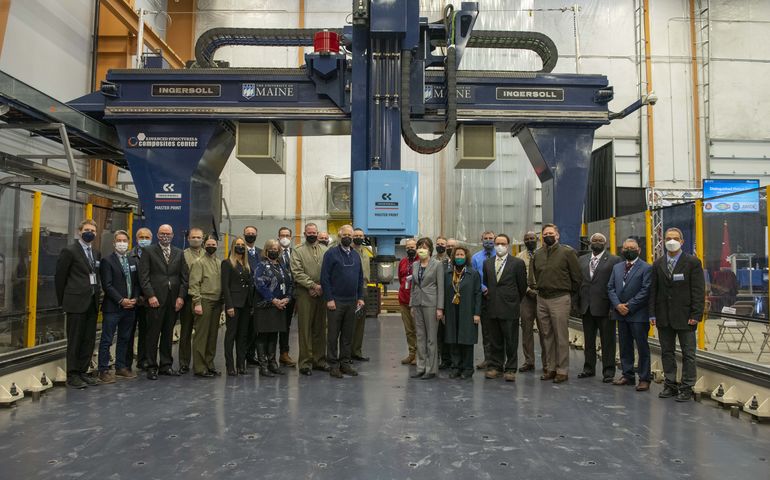UMaine says new 3D-printed USMC vessel is largest of its kind
 Courtesy / University of Maine
U.S. Sens. Susan Collins and Angus King, U.S. Department of Defense leadership and University of Maine officials participated in a Feb. 25 unveiling of the UMaine Advanced Structures and Composites Center's production of the world’s largest 3D-printed logistics vessel for the U.S. Department of Defense.
Courtesy / University of Maine
U.S. Sens. Susan Collins and Angus King, U.S. Department of Defense leadership and University of Maine officials participated in a Feb. 25 unveiling of the UMaine Advanced Structures and Composites Center's production of the world’s largest 3D-printed logistics vessel for the U.S. Department of Defense.
The University of Maine has unveiled two vessels that it made on a 3D printer for the U.S. Department of Defense.
The vessels, made public last week, were created at UMaine’s Advanced Structures and Composites Center in Orono, home to the world’s largest 3D printer.
The printer debuted in 2019, along with a non-functional 25-foot boat that was printed on it to demonstrate its capabilities.
At the time, the 25-footer was the largest 3D-printed object in the world.
The center printed the boat in 72 hours.
Now the longer of the two vessels recently completed is the largest 3D printed object in the world, according to a news release. Specifications were not provided.
The prototype logistics vessels are capable of transporting two shipping containers and a Marine rifle squad with three days of supplies.
The project was carried out as a collaboration between the center and the Marine Corps Systems Command’s Advanced Manufacturing Operations Cell. The cell conducts testing, experimentation and analysis to source innovative techniques and leverage advanced manufacturing technology.
The material used in the print process was a polymeric composite.
The longer of the two vessels simulates ship-to-shore movement of 20-foot containers representing equipment and supplies.
The second vessel can transport a Marine rifle-squad with organic equipment and three days of supplies.
The prototypes can be connected, maximizing the transport capability of a single-tow vehicle.
“The advancements made here will bolster domestic manufacturing and ultimately support our warfighters in the field,” said Barbara McQuiston, director of defense research and engineering for research and technology at the office of the Secretary of Defense.
The printer has both additive and precise subtractive manufacturing capabilities. It enables rapid prototyping for both defense and civilian applications.
Using traditional materials and methods, landing craft utility vessels can take over one year to produce.
By contrast, the center printed and assembled one of the two vessels in a month.
“Two years ago, we demonstrated that it was possible to 3D-print a 25-foot patrol vessel in three days,” said Habib Dagher, the center’s executive director. “Since then, partnering with the DOD, we have been improving material properties, speeding up the printing process and connecting our printer with high-performance computers that can monitor the print.”
The latest prototype vessel will be tested by the U.S. Marine Corps, he said.
The previous prototype was 3D-printed in 2020.
“These demonstration vessels represent an initial step toward defining future forward manufacturing capabilities, and also a balance between expendable system cost, performance and ease of manufacture,” said Kyle Warren, UMaine senior program manager and principal investigator on the project.
Mainebiz web partners
Ha Ha. Now let's see these in real life conditions. The ocean doesn't applaud and pat you on the back.
On the positive side - repairs can be made with Gorilla Glue.
As they say 'whatever floats your boat'. The Rocky Shoreline Picture Show.













1 Comments